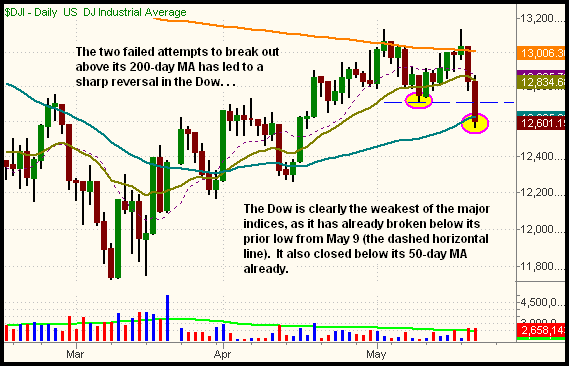|
The Wagner Daily ETF Report For May 22
Stocks built on the previous day's losses yesterday, as several key breaks of price support in the major indices served to intensify the selling. After opening higher, most of the broad-based indexes held above their prior day's lows throughout the first half of the day, but stocks tumbled after the 2:00 pm ET release of the minutes from last month's meeting of the Federal Open Market Committee. As it had already indicated, the Fed confirmed they're done lowering interest rates for a while. The S&P 500 swooned 1.6%, as both the Nasdaq Composite and Dow Jones Industrial Average plummeted 1.8%. The small-cap Russell 2000 and S&P Midcap 400 indices fell 1.2% and 1.5% respectively. All the main stock market indexes finished near their intraday lows.
Turnover surged higher across the board, clearly indicating the presence of institutional selling. Total volume in the NYSE increased 13%, while volume in the Nasdaq ticked 9% above the previous day's level. The sharp losses on firmly higher volume caused both the S&P 500 and Nasdaq Composite to register another negative "distribution day." Further, yesterday was the first day since April 1 that volume in the NYSE exceeded its 50-day average level. Unfortunately, it's quite bearish that the first volume spike in nearly two months also corresponded with such heavy declines in the S&P and Dow. Market internals were ugly. In both exchanges, declining volume trounced advancing volume by a margin of approximately 5 to 1.
In yesterday morning's Wagner Daily, we said of the previous day's higher volume losses in the NYSE that, "Since it was the fifth such day of institutional selling in recent weeks, traders should now be cautious on the long side of the S&P and Dow. A healthy market can withstand a few days of selling by mutual funds and hedge funds over a four-week period, but the presence of more than four "distribution days" often spells an end to a streak of bullish momentum." Tuesday's fifth day of institutional selling undoubtedly had a role in convincingly tipping the balance of power to the bears yesterday, causing stocks to suffer another "distribution day." Most indicators will occasionally give false signals, but volume is one indicator that never lies. We pay close attention to the market's price to volume relationship every day because changes in volume patterns are always the hallmark of institutional trading activity that moves the market from day-to-day. Mutual funds, hedge funds, and the like can hide their intentions in many ways, but their footprints are always left behind in the volume bars.
Yesterday's weakness caused substantial technical damage on the daily charts of the major indices. The S&P 500, Nasdaq Composite, and Dow Jones Industrial Average each sliced through their 20-day exponential moving averages. More notably, both the S&P and Dow firmly broke below support of their intermediate-term uptrend lines from their March lows -- the Dow had already done so on Tuesday. Showing a bit of relative strength, the Nasdaq still clings to support of its two-month uptrend line. Of these three broad-based indexes, the Dow is now clearly looking the worst. Take a look:

Having closed well below support of its prior low from May 9, the Dow is the first index to end its intermediate-term uptrend by setting a significant "lower low." The formation of a "lower high" over the next one to two weeks would indicate a change to a confirmed intermediate-term "downtrend." In addition to breaking through support of its prior low, notice the Dow has already fallen to close below its 50-day MA. If the Dow fails to move back above its 50-day MA in the coming days, the next major level of support is the April 15 low of 12,269. Note that level also corresponds with support of the 61.8% Fibonacci retracement from the March low to the May high. A break below convergence of the April 15 low and 61.8% Fibo retracement would likely send the Dow to test its 52-week lows.
Obviously, it could require a decent amount of time for the Dow to re-test its 52-week lows, but it's good to keep the possibility of that scenario in your head. With the Dow showing the most relative weakness, expect it to be the downside leader if the broad-based weakness continues. If, however, the bulls strike back, expect the Nasdaq to lead the way higher. The index has the least damaged chart pattern of the "big three" major indices. Within the Nasdaq, small and mid-cap stocks are holding up the best.
If you always "trade what you see, not what you think," it shouldn't matter whether the Dow pulls the broad market lower in the near-term, or if the Nasdaq prevails to pull stocks higher. Be prepared for either scenario by having a watchlist of industry sectors showing both relative strength and relative weakness. Now that the tide may be turning, we'll take an updated look at potential ETF setups within the industry sectors in the coming days. But for now, we'll just focus on managing our existing three open positions for maximum profitability. UltraShort Financial ProShares (SKF) is now showing an unrealized gain of 9% (9 points) since our May 19 entry, StreetTRACKS Gold Trust (GLD) is now in the plus column by more than 5% (4.6 points), and UltraShort Dow 30 ProShares (DXD) is showing a marked-to-market gain of 4% (2.2 points).
Open ETF positions:
Long - GLD, SKF, DXD
Short - (none)
Deron Wagner is the Founder and Head Trader of both Morpheus Capital LP, a U.S. hedge fund, and Morpheus Trading Group, a trader education firm launched in 2001 that provides daily technical analysis of the leading ETFs and stocks. For a free trial to the full version of The Wagner Daily or to learn about Wagner's other services, visit MorpheusTrading.com or send an e-mail to deron@morpheustrading.com.
|